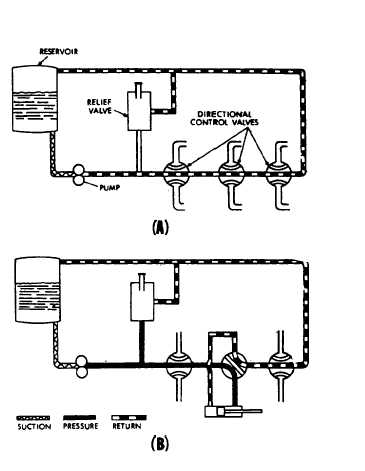Notice that figure 12-3 does not indicate the
physical location of the individual components
with respect to each other in the system. For
example, the 3/4-inch, solenoid-operated, 4-way
valve (10) is not necessarily located directly above
the relief valve (26). The diagram does indicate,
however, that the 4-way valve is located in the
working line, between the variable-displacement
pump and the 1-inch rotary selector valve, and
that the valve directs fluid to and from the rotary
actuator.
Combination Diagrams
A combination drawing uses a combination
of graphic, cutaway, and pictorial symbols. This
drawing also includes all interconnecting piping.
FLUID POWER SYSTEMS
A fluid power system in which the fluid in the
system remains pressurized from the pump (or
regulator) to the directional control valve while
the pump is operating is referred to as a closed-
center system. In this type of system, any number
of subsystems may be incorporated, with a
separate directional control valve for each
subsystem. The directional control valves are
arranged in parallel so that system pressure acts
equally on all control valves.
Another type of system that is sometimes used
in hydraulically operated equipment is the open-
center system. An open-center system has fluid
flow but no internal pressure when the actuating
mechanisms are idle. The pump circulates the fluid
from the reservoir, through the directional control
valves, and back to the reservoir. (See fig. 12-4,
view A.) Like the closed-center system, the open-
center system may have any number of subsystems,
with a directional control valve for each subsystem.
Unlike the closed-center system, the directional
control valves of an open-center system are always
connected in series with each other, an arrange-
ment in which the system pressure line goes
through each directional control valve. Fluid is
always allowed free passage through each control
valve and back to the reservoir until one of the con-
trol valves is positioned to operate a mechanism.
When one of the directional control valves is
positioned to operate an actuating device, as
shown in view B of figure 12-4, fluid is directed
from the pump through one of the working lines
to the actuator. With the control valve in this
position, the flow of fluid through the valve to
the reservoir is blocked. Thus, the pressure builds
up in the system and moves the piston of the
Figure 12-4.—Open-center hydraulic system.
actuating cylinder. The fluid from the other end
of the actuator returns to the control valve
through the opposite working line and flows back
to the reservoir.
Several different types of directional control
valves are used in the open-center system. One
type is the manually engaged and manually
disengaged. After this type of valve is manually
moved to the operating position and the actuating
mechanism reaches the end of its operating cycle,
pump output continues until the system relief
valve setting is reached. The relief valve then
unseats and allows the fluid to flow back to the
reservoir. The system pressure remains at the
pressure setting of the relief valve until the
directional control valve is manually returned to
the neutral position. This action reopens the
open-center flow and allows the system pressure
to drop to line resistance pressure.
Another type of open-center directional
control valve is manually engaged and pressure
disengaged. This type of valve is similar to the
valve discussed in the preceding paragraph;
however, when the actuating mechanism reaches
the end of its cycle and the pressure continues to
12-5

